Nishiaizu International Art Village
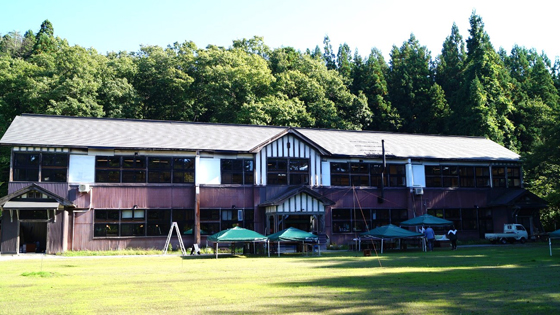
Nishiaizu International Art Village occupies a wooden former school building.
My interest was piqued when I heard about a run-of-the-mill rural community in Fukushima Prefecture that is attracting people through art. The town of Nishiaizu is located in the westernmost part of Fukushima Prefecture, near the border with Niigata Prefecture. Situated in a mountainous plain occupied by rice paddies and fields, the mainly agricultural town covers an area about half the size of Tokyo’s 23 central wards and consists of 89 hamlets with a total population of 6,300 people. It is a typical example of a depopulated area. In 2004 the Nishiaizu International Art Village opened here in a vacant old wooden building that used to be a junior high school. Since its establishment, the village has engaged in international exchange through art by inviting foreign artists, and it also holds an annual exhibition open to entries from across the nation. I visited the town during the 13th NIAV Exhibition 2018.
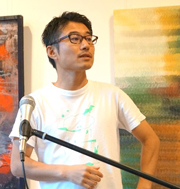
Director Yoshihiro Yabe
Yoshihiro Yabe, who is responsible for the art village’s activities as its current director, told me about the NIAV. Apparently, when the art village was founded, a person involved in its business suggested that they invite artists from around the world and provide them with a studio. Since that person had connections with foreign embassies in Japan, exchange with foreign artists began. Until now a total of nearly 200 foreign and Japanese artists have lived in the art village as artists-in-residence, engaging in creative activities and participating in exchange programs with local residents and others.
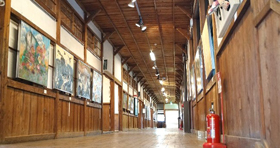
The art village corridor
Mr. Yabe himself was born in Nishiaizu as the nineteenth generation of a farming family that has continued its business since the Edo period (1603–1868). After studying design at the graduate school of the Nagaoka Institute of Design, he went to study landscape architecture1 at the graduate school of the University of Manitoba in Canada, acquiring master’s degrees from both universities. He then teamed up with a Canadian friend and began a design business in Canada and Shanghai.
After the Great East Japan Earthquake in 2011, however, he became concerned about Fukushima. Invited by an acquaintance, in April 2013 he took up the position of permanent staff member of the NIAV, the second person to hold that post. Since then, as well as activities directly related to art, such as the artist-in-residence program and the annual exhibition, he has been planning events related to local culture and cuisine in an effort to reappraise local culture and the daily-life wisdom of traditional rural communities, which are being lost in modern society.
1. Landscape architecture is environmental design utilizing the characteristics of the land and achieving harmony between people and nature.
The mountainous area of Nishiaizu, where the NIAV is located, has many endangered communities where aging is progressing and the population continues to decline. In these conditions, Mr. Yabe’s concept of the art village comprises three aspects. First, the NIAV needs to transform the evaluation of a rural community from a rural community being synonymous with inconvenience to a rural community as a wonderful and fun place with abundant nature and profound wisdom. Second, by assembling creative human resources, discovering and solving problems in a creative manner, and increasing options for the future, the NIAV must be a place where artistic people with special skills and attractions who might otherwise be underestimated in larger organizations can display their talents.
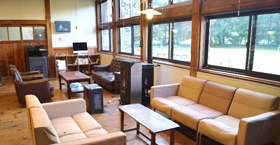
Exchange space in the art village
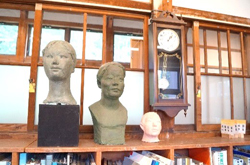
The interior decorations are vestiges of the building’s school days.
And third, the NIAV needs to foster human resources with the ability to learn new things by studying the past2. In other words, Mr. Yabe believes that while the declining population is certainly a problem, the loss of cultural DNA and local color is an even bigger problem.
2. Mr. Yabe used the Japanese proverb onko chishin, meaning “to learn the wisdom of our ancestors and therefrom acquire new knowledge and views.”
In human history, he said, artists have always been seeking new values in what is being lost. Moreover, art is related in a cross-sectional way with various fields, such as culture, history, tourism, education, and welfare, and it fits in well with Nishiaizu’s abundant nature. By using the art village as a place for exchange with artists, and by promoting the intermingling of the people who gather there with local people, Mr. Yabe wants to kick-start an old but new type of society in Nishiaizu.
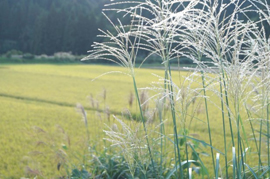
A rural area with abundant nature
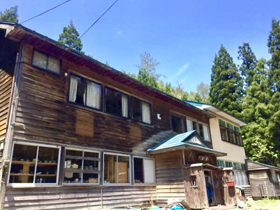
Dana Village on the site of a branch school
Mr. Yabe introduced me to several talented and attractive people who have settled in Nishiaizu in recent years. The first place I visited was the farmstay lodging Dana Village, operated by Minori Ogawa, who was born in the city of Kitakata in Fukushima Prefecture, and her partner Wik Van Der Weijden from the Netherlands. While studying nursing at university, Minori worked as a volunteer at orphanages and refugee camps in Japan and overseas. After that, although she did become a nurse, she decided that she wanted to be involved not in allopathic medicine but in holistic health, which supports not only the physical body but mind and spiritual health. In 2014, therefore, she went to Auroville3 in southern India, where for about two years she studied craniosacral biodynamics4 and organic farming. It was there that Minori met Wik as well.
3. Called the world’s largest ecovillage, Auroville is an international community founded in 1968 by Mirra Alfassa of France, the successor of the Indian philosopher Sri Aurobindo. It is an experimental environmental township that receives assistance from the Indian government and the United Nations Educational, Scientific, and Cultural Organization (UNESCO).
4. Craniosacral biodynamics is a therapy of US origin with a history of about 100 years. The therapist feels the patient’s blood, nerve, and cerebral spinal fluid circulation with his or her hands and, while talking to the patient, arouses the patient’s self-awareness of their internal condition and stress. A state of deep repose leads to a recovery of spiritual and physical health.
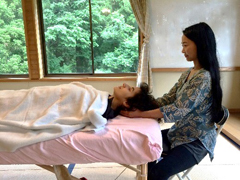
Upon returning to Japan, in April 2016 Minori established Dana Village on the site of a former branch elementary school in the Aza district of Nishiaizu. When I asked for an example of a person whose poor physical condition had improved through the therapy, Minori told me about a person who had trouble with personal relationships and high blood pressure who spent five days at Dana Village. After returning to normal life, the person reported that their blood pressure had dropped. That person’s daily menu at Dana Village involved doing agricultural work from 5 to 8 in the morning, followed by a little yoga, walking and reading, eating vegetarian food, and connecting with their own physical and mental condition through craniosacral biodynamics. Minori added that the person had also benefited from living together with people from various other countries and experiencing a rural lifestyle with cats running all over the place. I like cats, and I like international exchange too, so I think I understand.
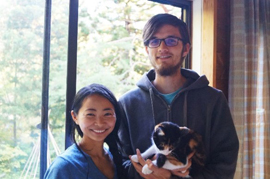
Minori and Wik
Minori explained that they find guests through online travel agents, such as Booking.com and Airbnb, and also by using worldwide overseas volunteer platforms like WWOOF and HelpX. In the case of people who apply as volunteers, Dana Village provides accommodation and meals in exchange for working on an organic vegetable farm run by Minori and her father, tidying the rooms, and chopping wood. In August 2018 Dana Village had a total of 118 guests, of whom 70 were foreigners, including volunteers.
The second couple that I visited was Momoe Narasaki and William Shum, known locally as Momo and Will. Momoe and William studied graphic design at a university in New York and, upon graduation, set up a creative unit called Studio ITWST. After working in New York and Belgium, they moved to Japan and became artists-in-residence5 at the NIAV for a year. Taking a liking to Nishiaizu, they decided to settle there and opened Barbarian Books in a self-renovated 70-year-old house that used to be a drapery store.
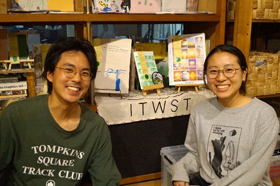
William and Momoe
5. Briefly, in the artist-in-residence program, regardless of whether they are professionals or amateurs, people engaged in creative activities (including musicians, chefs, engineers, etc.) submit a written plan of their proposed activities in line with the art village’s concept. Artists who pass the screening are then provided with space in the art village for production, exhibitions, and so on and also accommodation in a house attached to the village, with free utilities, for a maximum of one year. Artists-in-residence are expected to participate in exchange events and to assist in discovering and creating local attractions.
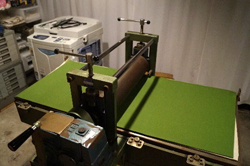
Risograph printer and etching press
When I asked what kind of place Barbarian Books was, the two of them looked at each other, laughed, and replied, “A design studio, a library . . . You could call it a community space.” In the earthen entrance there was a risograph printer and etching press, and in the facing raised tatami space, where the shopkeeper and customers probably used to chat in the drapery store days, there was a wooden table and bookshelf lined with English-language zines (small-circulation self-published books and magazines issued mainly for nonprofit purposes) and design-related books. Momoe told me, with a laugh, that this space, where cats run around, has become a play area for neighborhood kids.
Momoe and William disliked the idea of doing faceless graphic design work in a large city, such as New York, where you do not meet the people requesting jobs and cannot tell whether your work is being useful or not, and so began to search for a more pleasant workplace for themselves. In Nishiaizu they make a living by designing packaging and leaflets for the processed goods made by local tradespeople and producing printed matter for the art village. “Here,” they said gleefully, “clients introduce their acquaintances, so we know the people we are working for.”
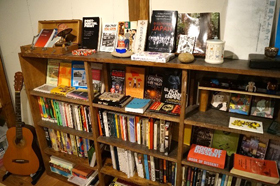
Bookshelf at Barbarian Books
As I was wondering to myself whether such work could really be satisfying for them, William seemed to read my thoughts. “Our goal is not to become rich,” he said. “You may think of artists as people who earn money by selling their art. But for me, an artist is a person who follows his or her own desired lifestyle.” There are many people like that in Nishiaizu, he added—not only the characters appearing in this article but among the farmers as well.
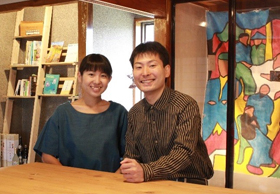
Yuko and Yusuke
After my first day in the town, I stayed at the Hitotoki Guesthouse, which Mr. Yabe introduced to me. The owners are a married couple, Yusuke and Yuko Sasaki. Yusuke is from the city of Fukushima and Yuko from Koriyama. They moved to Nishiaizu to fulfill their dream of running a guesthouse. While their aim is to become full-fledged guesthouse owners, at present Yusuke also works for the Nishiaizu Farmstay Business Promotion Council and Yuko for the local government’s department of commerce, industry, and tourism as a district revitalization cooperator.
Yusuke and Yuko, with the help of friends, renovated a vacant house themselves and opened the guesthouse in May 2018. Although the exterior bears traces of the old empty house, the interior has been remodeled in an extremely neat and tidy way. When they showed me through to the common space, the first thing I noticed was a display area decorated with a picture by Momoe and William, whom I had just visited.

Common space
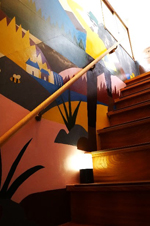
Art bedecks the stairs as well.
In addition, the stairs leading up to the guest rooms on the second floor were decorated with lovely pictures drawn by an artist from Hong Kong who had stayed here in the summer. While the guesthouse itself certainly is a splendid restoration, I couldn’t help thinking that it was these works of art that had blown a fresh breeze into a vacant house that had stood empty for 20 years.
On the morning of the second day I went to see Otame, a house where people who are thinking of moving to Nishiaizu can stay temporarily to get a taste of living there. People can apply to stay at Otame if they are contemplating a move to Nishiaizu, are aged 18 years or over, have received settlement counseling, have participated in a program to learn about conditions in Nishiaizu, and can respond if approached by the media. They can stay there for a period of at least one week to a maximum of one month at a cost of \15,000, regardless of the duration of their stay. (Visitors themselves pay the cost of meals and utilities.) The cost is the same for one person or several persons. Looking around, I would say that there is plenty of room for a family of three or four to stay there. Otame shows the town’s positive stance toward welcoming settlers.
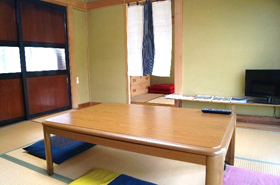
Japanese-style room at Otame
As the final stop on my tour of the town, I went to see the 13th NIAV Exhibition 2018 at the art village. This year there were 79 works on display—32 in the youth category and 47 in the general category. The exhibited works were by entrants from not only Fukushima Prefecture but also mainly northern Japan and Hiroshima Prefecture and Shimane Prefecture in the west. The works displayed along the corridor and in the former classrooms of the wooden school building, which exudes a kind of human warmth, were exhibited as if to accentuate one another. I felt impressed in a way that was different from that experienced when seeing the works of famous artists in galleries in urban centers.
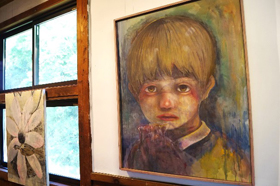
Exhibits blend with the greenery outside
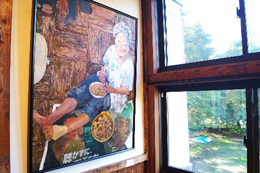
That feeling came not only from the warmth of the wooden school building but also the atmosphere of the whole venue itself, which was somehow very exhilarating. “External light would not usually be shone on exhibited works,” said Mr. Yabe, “but here it is a special feature of the exhibition.” Hearing his explanation, I understood the reason for that feeling of exhilaration. In this exhibition, the natural light shining through the windows and the greenery of the shrubs and trees surrounding the building blend with the works of art to evoke what is, I felt, a unique sensation that cannot be experienced elsewhere.
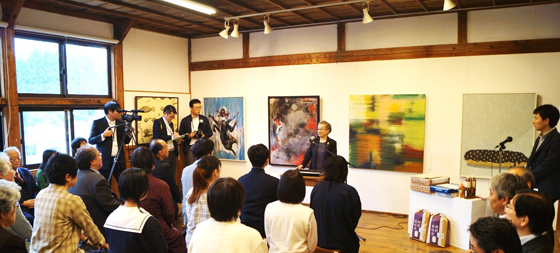
Commendation ceremony for winning NIAV exhibition contestants
At a glance, Nishiaizu looks like just any other depopulated community, but I came away with the feeling that, centered on the NIAV, an old yet new type of society is slowly but surely taking shape there. The people bringing about this transformation, locals and newcomers alike, are utilizing their respective specialties, cooperating with one another, and living in an artistic way.
There is an elderly local farmer who Momoe and William respect very much. His nickname is Hide-jii (Grandpa Hide), and he knows everything about farming work. Not only that, he knows everything about local nature as well. They told me about how a telephone directory that Hide-jii had given them had contained 47 pressed four-leaf clovers. “We couldn’t find a four-leaf clover if we tried!” they said, adding that “Maybe Hide-jii can see things that others cannot see.” Momoe and William published a small zine about this incident, which seems to symbolize the new way of living that is emerging from the meeting of local wisdom and new talent from outside.
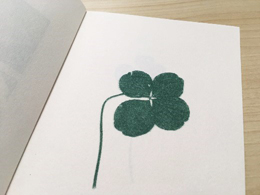
Describing the severe winter task of clearing snow as exercise, Mr. Yabe has also launched an association to encourage urban people to enjoy this chore. This is a good example of finding fun even in a daily activity that is generally seen in negative terms, promoting exchange through this activity between locals and outsiders coming to the town, and creating and fostering a unique Nishiaizu culture with both retro and new values. It is an artistic lifestyle. “Yes,” I thought, “I must come again in winter and get some snow-clearing exercise!”

Nishiaizu International Art Village (Director: Yoshihiro Yabe)
5752 Uenohara Michiue, Sasagawa, Shingo, Nishiaizu, Yama-gun, Fukushima Prefecture, 969-4622
TEL:0241-47-3200
URL: http://nishiaizu-artvillage.com/
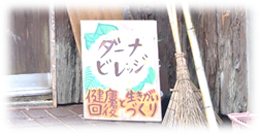
Dana Village (Representative: Minori Ogawa)
655 Ienokamihei, Chozaburo, Nozawa, Nishiaizu, Yama-gun, Fukushima Prefecture, 969-4406
TEL:050-5583-9391
E-mail: Contact@danavillage.com
URL: https://www.danavillage.com/

Barbarian Books (Studio ITWST: Momoe Narasaki and William Shum)
2518-3 Kamiokinohara, Kaminojiri, Nishiaizu, Yama-gun, Fukushima Prefecture, 969-4512
TEL:080-4684-0130
URL: http://www.barbarianbooks.institute/

Hitotoki Guesthouse (Owners: Yusuke and Yuko Sasaki)
2650-1 Shimookinohara, Kaminojiri, Nishiaizu, Yama-gun, Fukushima Prefecture, 969-4512
E-mail: hitotoki.fuku@gmail.com
URL: http://www.gh-hitotoki.com/
